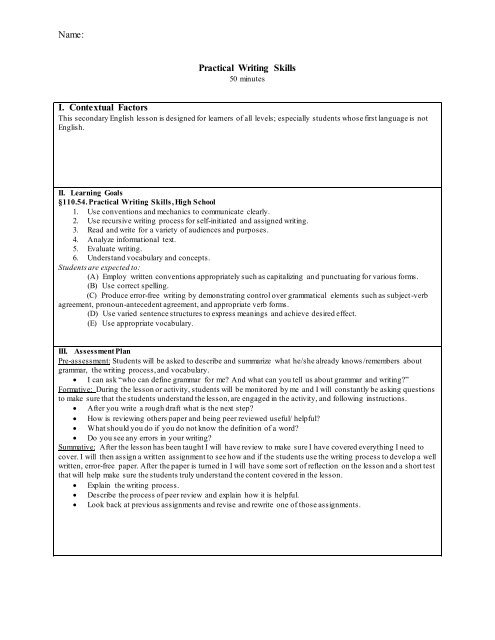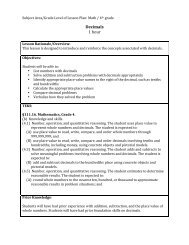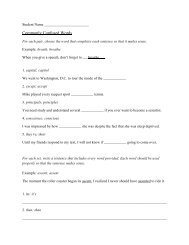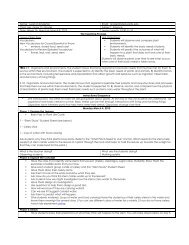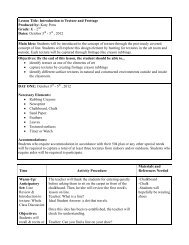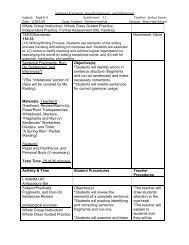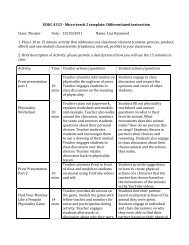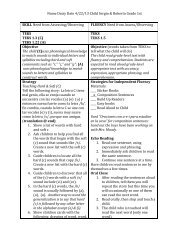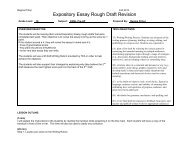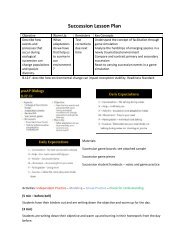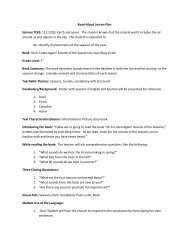Lesson Plan - St. Edwards University
Lesson Plan - St. Edwards University
Lesson Plan - St. Edwards University
Create successful ePaper yourself
Turn your PDF publications into a flip-book with our unique Google optimized e-Paper software.
Name:Practical Writing Skills50 minutesI. Contextual FactorsThis secondary English lesson is designed for learners of all levels; especially students whose first language is notEnglish.II. Learning Goals§110.54. Practical Writing Skills, High School1. Use conventions and mechanics to communicate clearly.2. Use recursive writing process for self-initiated and assigned writing.3. Read and write for a variety of audiences and purposes.4. Analyze informational text.5. Evaluate writing.6. Understand vocabulary and concepts.<strong>St</strong>udents are expected to:(A) Employ written conventions appropriately such as capitalizing and punctuating for various forms.(B) Use correct spelling.(C) Produce error-free writing by demonstrating control over grammatical elements such as subject-verbagreement, pronoun-antecedent agreement, and appropriate verb forms.(D) Use varied sentence structures to express meanings and achieve desired effect.(E) Use appropriate vocabulary.III. Assessment <strong>Plan</strong>Pre-assessment: <strong>St</strong>udents will be asked to describe and summarize what he/she already knows /remembers aboutgrammar, the writing process, and vocabulary. I can ask “who can define grammar for me? And what can you tell us about grammar and writing?”Formative: During the lesson or activity, students will be monitored by me and I will constantly be asking questionsto make sure that the students understand the lesson, are engaged in the activity, and following instructions. After you write a rough draft what is the next step? How is reviewing others paper and being peer reviewed useful/ helpful? What should you do if you do not know the definition of a word? Do you see any errors in your writing?Summative: After the lesson has been taught I will have review to make sure I have covered everything I need tocover. I will then assign a written assignment to see how and if the students use the writing process to develop a wellwritten, error-free paper. After the paper is turned in I will have some sort of reflection on the lesson and a short testthat will help make sure the students truly understand the content covered in the lesson. Explain the writing process. Describe the process of peer review and explain how it is helpful. Look back at previous assignments and revise and rewrite one of those assignments.
Name:IV. Design for/Delivery of Instruction/Activities/Actions (of teacher and students)Materials:1. Teacher: Projector White board and markers Worksheets Vocabulary sheet Power point2. <strong>St</strong>udents: Journal Writing utensil DictionaryIntroduction:1. Pre-assessment:10 minutesThe first thing I will do after I introduce what we are going to be talking about is hand out a preassessmentthat includes grammar terms and asks the students how much they remember about thewriting process. Me: “today we will be talking about the writing process and how to write an error-free paper.” I will then pass out a pre-assessment handout to see what the students know and remember aboutgrammar and the writing process. Then I will pick up the handout and we will talk about it as a class.2. <strong>Lesson</strong>: 25 minutes I will open my power point and begin my lesson. I will be sure to ask the students to follow along,take notes, and ask questions. Me: “Okay class there are five basic steps in the writing process. Who can tell me the first step?”…second step?...third step?...fourth step?...and last step? I will pull up a diagram of the writing process on my power point so The students have somethingto see and write down. Me: “Before I talk about the steps and explain them, I want to review what a successful essaylooks like. First the paper must have a clear introduction with a thesis statement. Then the body ofthe essay typically includes three paragraphs, each one must address something that you mentionin your thesis statement. Lastly the paper must have a conclusion that sums up what has beenwritten in the essay.”“Great. The first step is to pre-write. The best way to start the pre-writing is to think about theprompt, write down any ideas, and design an outline to help organize your paper.”“The second step is going to be the writing a first draft. This is where you will write out yourpaper and write paragraphs even if they are not perfect. There will be time for revision later.”“The third and fourth steps are the most important because they are going to assure that your paperhas no mistakes. The third step is revising, in this step you will read and review your paper andmake sure it flows well.”“The fourth step is proofreading; in this step you will be able to have peer-review session. This isthe time to check for any last minute grammatical errors that you may have missed in therevision.”“Finally you write a final draft; by this point you should have a well-written, error-free paper.”In between my explanation of each of the steps of the writing process I will pull up an example ofwhat the particular step looks like. I want to try and demonstrate or model each step for mystudents. “Now class, I would like to take this time to transition to a small activity that will help us practicewhat we have just learned.”3. Activity: 10 minutes I will do an activity with the class in small groups I will ask them to write down answers toquestions and write examples on the board for me. Me: “Now I have a few practice problems and questions that I want to go over with you guys. Butfirst I am going to split you guys up into small groups of 3-4. Once you are in your groups I needone person to get out a piece of paper and be the group writer. Also choose someone to be thespokes person for your group.” “In your groups talk about the writing process and explain in your own word the steps to writing awell-written paper.”
Name:Part II-<strong>Lesson</strong> <strong>Plan</strong>ning by K.J Wagner. I got good Ideas from this article about how to start writing my lessonplan.In the article A Brief Primer on Differentiation I learned how to plan out my curriculum based on thediversity of my students and their [the students] different learning abilities and styles. I made sure toconsider all the elements of a classroom that I can differentiate and do the best I could to make my lessonplan work as smoothly as possible and keep all of my students engaged.


